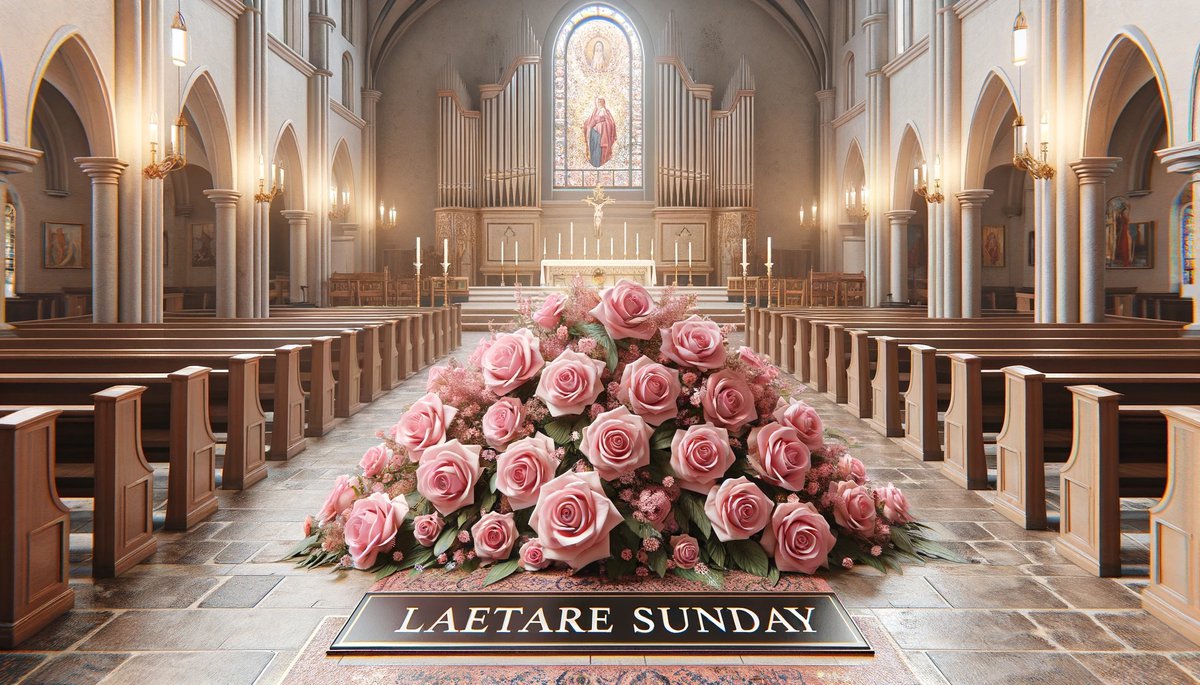Home>Special Themes>What Is The Fourth Sunday Of Lent Called?


Special Themes
What Is The Fourth Sunday Of Lent Called?
Published: February 27, 2024
Ericka Andersen, an editor at Christian.net, expertly merges digital strategy with content creation, focusing on faith and societal issues. Her communication skills enhance the platform's engaging narratives, fostering meaningful dialogue on belief's impact on society.
Discover the significance of the Fourth Sunday of Lent, also known as Laetare Sunday, and its special themes. Explore the traditions and customs associated with this important day.
(Many of the links in this article redirect to a specific reviewed product. Your purchase of these products through affiliate links helps to generate commission for Christian.net, at no extra cost. Learn more)
Table of Contents
The Meaning of Laetare Sunday
Laetare Sunday, also known as the Fourth Sunday of Lent, holds a special significance within the liturgical calendar of the Roman Catholic Church. The term "Laetare" is derived from the Latin word for "rejoice," and this Sunday is marked by a sense of joyful anticipation as it represents a halfway point through the Lenten season. It serves as a brief respite from the somber tone of Lent, offering a glimpse of the joy that awaits with the arrival of Easter.
-
Rejoicing in the Midst of Lent: Laetare Sunday is a time for celebration and hope. It encourages believers to rejoice in the Lord's mercy and to look forward to the coming redemption. This sense of joy is reflected in the liturgical color for the day, which is rose or pink, symbolizing the lightening of the penitential mood of Lent.
-
A Call to Rejoice: The traditional entrance antiphon for Laetare Sunday begins with the words "Laetare Jerusalem," which translates to "Rejoice, O Jerusalem." This call to rejoice is a reminder of the ultimate victory of Christ over sin and death, inspiring believers to find joy even in the midst of their Lenten sacrifices.
-
The Symbolism of Refreshment: In addition to the spiritual significance, Laetare Sunday also carries a sense of physical refreshment. In some traditions, this day is marked by relaxation of Lenten disciplines, allowing for a break from the usual fasting and abstinence. This temporary reprieve serves as a reminder that while Lent is a time of penance, it is also a season of hopeful expectation.
-
Encouragement for the Faithful: Laetare Sunday serves as a source of encouragement for those who may be struggling with the challenges of Lent. It offers a reminder that the journey of faith is not solely marked by sacrifice and self-denial, but also by the promise of joy and renewal. This message of hope is meant to uplift and strengthen the faithful as they continue their Lenten observance.
-
Looking Ahead to Easter: As the midpoint of Lent, Laetare Sunday also serves as a turning point, directing the focus of believers towards the approaching celebration of Easter. It marks a shift from the introspective nature of the early Lenten period to a more forward-looking attitude, as the Church begins to anticipate the joy of Christ's resurrection.
In essence, Laetare Sunday embodies the dual themes of rejoicing and anticipation, offering a glimpse of the joy that awaits at the culmination of the Lenten season. It serves as a reminder of the ultimate victory of Christ and encourages believers to persevere in their Lenten observance with a sense of hope and joy.
Read more: What Is The Last Sunday Before Lent Called
Traditions and Customs of the Fourth Sunday of Lent
The Fourth Sunday of Lent, also known as Laetare Sunday, is marked by several traditions and customs that hold deep significance within the Church. These practices serve to enrich the spiritual experience of this halfway point in the Lenten season and contribute to the sense of joyful anticipation that characterizes this particular Sunday.
1. Rose-colored Vestments:
One of the most distinctive customs associated with Laetare Sunday is the use of rose-colored vestments by clergy during the liturgical celebrations. This departure from the usual violet or purple vestments of Lent symbolizes a shift in tone from penitence to joy. The rose color serves as a visual reminder of the approaching joy of Easter and the promise of redemption.
2. Relaxation of Lenten Disciplines:
In some traditions, Laetare Sunday offers a temporary relaxation of the Lenten disciplines. This may include a dispensation from the usual fasting and abstinence practices, allowing for a brief respite from the rigors of Lent. This relaxation serves as a moment of physical refreshment and a glimpse of the joy that awaits at the end of the Lenten journey.
3. Flowering the Cross:
Another common tradition associated with the Fourth Sunday of Lent is the custom of "flowering the cross." During this practice, a plain wooden cross is adorned with fresh flowers, symbolizing the transformation from the barrenness of Lent to the beauty and new life of Easter. This act serves as a visual representation of the spiritual journey from penance to rejoicing.
Read more: What Are The 4 Sundays Of Advent Called?
4. Celebrating Mothering Sunday:
In certain Christian traditions, the Fourth Sunday of Lent is also observed as Mothering Sunday. This observance has historical roots in the practice of visiting one's "mother church" or the church where one was baptized. Over time, it has evolved into a day to honor mothers and maternal figures, often accompanied by the giving of flowers and small gifts.
5. Emphasis on Joyful Music and Readings:
The liturgical celebrations of Laetare Sunday often feature a shift towards more joyful music and readings. This includes the singing of hymns and antiphons that reflect the themes of rejoicing and hope. The Scripture readings for the day also emphasize the message of joy and anticipation, setting the tone for the remainder of the Lenten journey.
6. Focus on Rejoicing and Encouragement:
Overall, the traditions and customs associated with the Fourth Sunday of Lent serve to emphasize the themes of rejoicing and encouragement. They provide a brief interlude of joy within the Lenten season, offering a glimpse of the ultimate victory of Christ and the promise of redemption. These practices contribute to the overall spiritual significance of Laetare Sunday and inspire believers to continue their Lenten observance with renewed hope and joy.
The Symbolism Behind the Rose-colored Vestments
The use of rose-colored vestments on Laetare Sunday holds deep symbolism within the liturgical traditions of the Church. The shift from the customary violet or purple vestments of Lent to the rose color serves as a visual representation of the changing tone of the season. The rose color symbolizes a moment of joyful anticipation and serves as a reminder of the approaching joy of Easter. It represents a temporary reprieve from the somber penitential mood of Lent, offering a glimpse of the light that awaits at the end of the Lenten journey.
The rose-colored vestments also carry a message of hope and encouragement for the faithful. As the halfway point of Lent, Laetare Sunday marks a turning point in the season, directing the focus of believers towards the approaching celebration of Easter. The use of rose serves as a visual cue for this shift in emphasis, reminding the faithful that while Lent is a time of penance and self-reflection, it is also a season of hopeful expectation. The rose color conveys the message that the journey of Lent is not solely marked by sacrifice and self-denial, but also by the promise of joy and renewal.
Furthermore, the symbolism of the rose-colored vestments extends to the broader themes of redemption and spiritual transformation. The color rose, with its delicate hue, evokes a sense of beauty and new life, serving as a powerful symbol of the transformation that occurs through the grace of Christ. It signifies the transition from the barrenness of the Lenten desert to the blossoming of new life in the resurrection of Christ. The use of rose-colored vestments on Laetare Sunday thus becomes a visual representation of the spiritual journey from penance to rejoicing, from darkness to light.
In essence, the symbolism behind the rose-colored vestments on Laetare Sunday speaks to the dual themes of joy and anticipation that characterize this halfway point in the Lenten season. It serves as a visual reminder of the ultimate victory of Christ over sin and death, inspiring believers to find joy even in the midst of their Lenten sacrifices. The use of rose-colored vestments conveys a message of hope, renewal, and the promise of redemption, enriching the spiritual experience of Laetare Sunday within the liturgical calendar of the Church.
Read more: What Is Third Sunday Of Advent Called
Celebrating Mothering Sunday on the Fourth Sunday of Lent
Mothering Sunday, observed on the Fourth Sunday of Lent, holds a special place in the hearts of many Christians, particularly in the United Kingdom and other parts of the world. This observance has historical roots in the practice of visiting one's "mother church" or the church where one was baptized. Over time, it has evolved into a day to honor mothers and maternal figures, often accompanied by the giving of flowers and small gifts.
The tradition of Mothering Sunday provides an opportunity for individuals to express their love and gratitude towards their mothers and motherly figures. It serves as a day of appreciation for the nurturing and selfless love that mothers provide, acknowledging their significant role in the lives of their children and families. This observance allows for the celebration of the maternal bond and the expression of heartfelt sentiments towards mothers, grandmothers, and other maternal figures who have made a positive impact in the lives of others.
In addition to honoring individual mothers, Mothering Sunday also carries a broader significance within the Christian community. It serves as a reminder of the maternal attributes of God and the nurturing love of the Church. The imagery of God as a loving and caring parent is often emphasized during this observance, highlighting the compassionate and nurturing qualities that are embodied in the divine.
The celebration of Mothering Sunday is often accompanied by the giving of flowers, particularly daffodils, which are in bloom during this time of year. The tradition of presenting flowers to mothers and maternal figures symbolizes appreciation, love, and the arrival of spring. This act of gifting flowers serves as a tangible expression of gratitude and affection, adding a touch of beauty and joy to the observance of Mothering Sunday.
Overall, the celebration of Mothering Sunday on the Fourth Sunday of Lent provides a meaningful opportunity to honor and appreciate the maternal figures in one's life. It serves as a day of expressing love, gratitude, and respect towards mothers and motherly figures, while also highlighting the nurturing attributes of God and the Church. This observance enriches the spiritual significance of the Fourth Sunday of Lent, adding a layer of warmth, love, and appreciation to the Lenten season.













